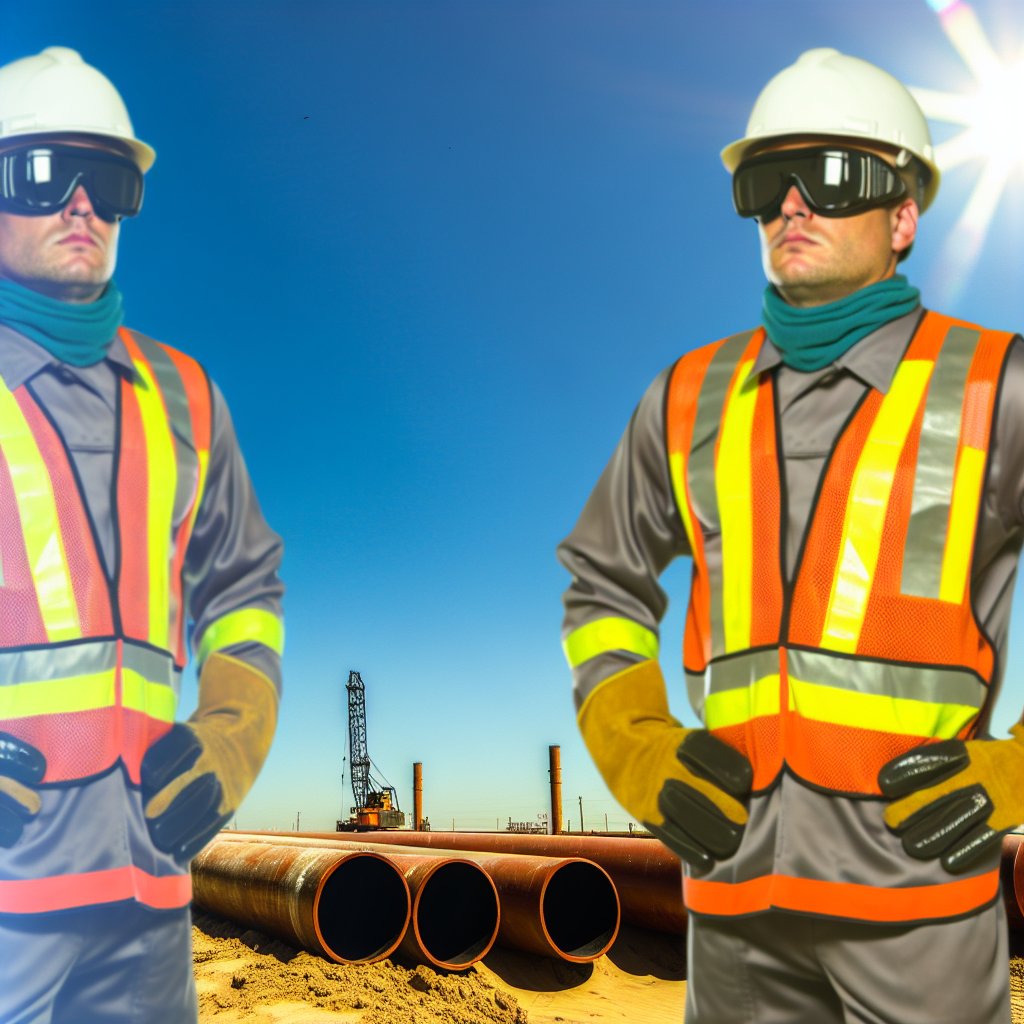Introduction:
Proper workwear is crucial for pipelayers to ensure safety and optimal performance.
The physically demanding nature of pipelaying requires gear that can enhance comfort and protect against potential hazards.
Protective clothing for pipelaying:
When it comes to working in the pipeline industry, having durable clothing that can withstand rough conditions is essential.
Pipelayers are often exposed to various hazards such as sharp objects, extreme temperatures, and chemical exposure.
Therefore, investing in high-quality workwear is crucial to ensure safety and comfort while on the job.
Key features for pipelayer workwear:
- Reinforced knees: Pipelayers spend a significant amount of time kneeling on hard surfaces, which can cause wear and tear on regular pants.
- High-visibility colors: Working on pipelines often involves heavy machinery and large construction sites, making visibility a top priority.
- Flame-resistant materials: Pipelines may contain flammable materials, so it’s important to wear clothing made from flame-resistant materials to reduce the risk of fire-related injuries.
Recommendations for brands or specific products:
There are several brands that specialize in workwear for pipelayers, offering a range of products designed to meet the unique needs of this profession.
- Carhartt: Known for their durable and rugged workwear, Carhartt offers a selection of work pants with reinforced knees and flame-resistant materials.
- Ariat: Ariat provides workwear that combines performance and style, with options for high-visibility colors and flame-resistant materials.
- Bulwark: Bulwark is a top choice for flame-resistant workwear, offering a variety of clothing options designed to meet safety regulations for pipelaying.
When choosing workwear for pipelaying, it’s important to consider the specific hazards you may encounter on the job and select clothing that provides the necessary protection.
By investing in high-quality workwear with key features such as reinforced knees, high-visibility colors, and flame-resistant materials, you can ensure your safety and comfort while working in the pipeline industry.
Footwear for pipelaying
When it comes to working as a pipelayer, having the right footwear is crucial for your safety and comfort on the job.
Here are some key points to consider:
Importance of supportive and slip-resistant footwear
Pipelayers often work in challenging environments that may involve uneven terrain, mud, or wet conditions.
To ensure stability and prevent accidents, it’s essential to wear footwear that provides good support and traction.
Slip-resistant soles can help prevent slips, trips, and falls, reducing the risk of injury.
Different types of boots suitable for pipelayers
- Steel-toed boots: These are a popular choice for pipelayers as they offer protection against heavy objects and sharp materials that could potentially cause foot injuries.
- Waterproof boots: Given the nature of the work, waterproof boots can keep your feet dry and comfortable, especially when working in wet or muddy conditions.
- Insulated boots: For pipelayers working in cold climates, insulated boots can provide warmth and comfort during long hours on the job.
Tips on choosing the right boots for comfort and safety
- Fit: Make sure the boots fit properly to prevent blisters or discomfort during long hours of work.
- Support: Look for boots with good arch support to reduce fatigue and prevent injuries from standing for extended periods.
- Material: Choose high-quality materials that are durable and provide adequate protection against potential hazards on the job site.
- Style: Opt for boots with features like lace-up closures or adjustable straps for a secure fit that can be customized to your comfort level.
- Maintenance: Regularly clean and inspect your boots to ensure they remain in good condition and provide optimal protection while working.
By investing in the right footwear and following these tips, pipelayers can work comfortably and safely, knowing that their feet are protected from potential hazards on the job site.
You Might Also Like: Training Programs for Aspiring Insulation Workers
Headgear and Eye Protection:
- Wearing helmets or hard hats is crucial for protecting the head from falling objects or bumps.
- Safety glasses or goggles are essential to prevent eye injuries from debris or chemicals.
- Recommended brands like Pyramex and 3M offer ANSI-certified protective eyewear.
Importance of Headgear
Head injuries are common in construction, making helmets or hard hats a non-negotiable piece of equipment for pipelayers.
These protective headgear items are designed to withstand impacts from falling debris, tools, or accidental bumps against structures.
Invest in a quality helmet that meets ANSI standards to ensure maximum protection on the job.
Significance of Eye Protection
Eye injuries can be severe and irreversible, which is why safety glasses or goggles are mandatory gear for pipelayers.
These protective eyewear items shield the eyes from flying debris, dust, or chemicals present on the job site.
Transform Your Career Today
Unlock a personalized career strategy that drives real results. Get tailored advice and a roadmap designed just for you.
Start NowOpt for reputable brands like Pyramex or 3M that offer a wide range of ANSI-certified safety glasses to ensure your eyes are well-protected at all times.
Gain More Insights: Cost Breakdown: Professional vs. DIY Window Cleaning
Gloves and Hand Protection
When it comes to pipelayer workwear, gloves play a crucial role in providing both dexterity and protection from sharp objects.
Here are some key points to consider:
Need for Gloves Offering Dexterity and Protection
- Working on a pipeline project often involves handling various tools and materials that can pose a risk of cuts or injuries to the hands.
- Gloves with a good grip and flexibility allow pipelayers to perform tasks with precision and accuracy without compromising safety.
Benefits of Impact-Resistant Gloves
- Impact-resistant gloves are designed to absorb and distribute the force of impact, reducing the risk of hand injuries from heavy tools or equipment.
- These gloves provide an extra layer of protection for pipelayers working in high-risk environments where accidents can occur.
Tips for Choosing the Right Size and Fit
- It is essential to select gloves that fit snugly without being too tight, as they should allow for comfortable movement and flexibility.
- Consider the specific tasks and hazards involved in pipelaying work when choosing the material and thickness of the gloves for optimal protection.
- Choose gloves with reinforced palms and fingertips for added durability and wear resistance in areas prone to wear and tear.
- Look for adjustable wrist closures or Velcro straps to ensure a secure fit that prevents debris from entering the gloves while working.
By investing in high-quality gloves that offer both dexterity and protection, pipelayers can enhance their safety and efficiency on the job.
It is essential to prioritize comfort and fit when selecting the right gloves for pipelaying work to ensure maximum performance and safety.
Discover More: Green Building: Eco-Friendly Drywall Options

Preparing for Varying Weather Conditions
When working outdoors as a pipelayer, it’s important to be prepared for varying weather conditions.
Layering your clothing is essential to ensure you stay comfortable and protected throughout your workday.
Importance of Layering Clothing
- Layering clothing helps regulate body temperature in changing weather.
- It allows you to add or remove layers as needed to stay comfortable.
- Helps to manage moisture and keep you dry during physical activity.
- Provides insulation against cold temperatures to prevent hypothermia.
Recommended Clothing Layers
- Start with a moisture-wicking base layer to keep sweat away from your skin.
- Choose an insulating mid-layer like a fleece jacket or thermal top for warmth.
- Top it off with a waterproof and windproof outer layer to protect against elements.
- Consider pants with reinforced knees for added durability when kneeling or crouching.
Role of Accessories in Keeping Warm
- Wearing a hat is crucial to prevent heat loss through the head.
- Scarves or neck gaiters can provide additional protection against cold winds.
- Gloves are essential to protect your hands from frostbite and injuries.
- Choose insulated, waterproof gloves for optimal warmth and dexterity.
By following these guidelines and investing in quality layering pieces and accessories, pipelayers can ensure they are prepared for any weather conditions they may encounter on the job.
Stay warm and stay safe!
Learn More: Pest Control Work: Legal and Ethical Issues
Tools and Equipment Carrying Options
When it comes to pipelayer workwear, having the right tools and equipment at hand is crucial for getting the job done efficiently and safely.
Here are some suggestions for carrying options that can help you stay organized and ready on-site.
Gear Belts or Tool Pouches
- Consider using gear belts or tool pouches to keep your necessary tools within arm’s reach.
- These options provide easy access to items like wrenches, pliers, and measuring tape.
- Choose a belt or pouch with multiple compartments to stay organized and prevent losing tools.
Benefits of Backpacks or Tool Bags
- Backpacks or tool bags are also great options for transporting equipment on-site.
- These larger carrying solutions can accommodate bulkier items like drills and saws.
- With adjustable straps and padded backs, backpacks provide comfort during long workdays.
Tips for Organizing and Securing Tools
- Invest in tool organizers or storage boxes to keep small parts and accessories in one place.
- Use carabiners or clips to secure tools to your belt or bag to prevent them from falling off.
- Label your tools and equipment for easy identification and quick access while working on pipelines.
By utilizing these tools and equipment carrying options, you can streamline your workflow and improve your overall productivity as a pipelayer.
Stay organized, stay prepared, and stay safe on the job.
Importance of Proper Workwear for Pipelayers
Proper workwear is crucial for pipelayers as it enhances safety and performance on the job.
Investing in quality gear can make a significant difference in the overall work experience.
By selecting appropriate pipelaying workwear, individuals prioritize their safety and well-being on site.
Showcase Your Business Today
Reach thousands of readers actively exploring professional services. Publish your business profile and grow your audience now.
Publish NowAdditional Resources
1940-1949 – Prices and Wages by Decade – Library Guides at …
What Is Blue Collar? Definition and Job Examples
[E-Books for Sale]
The Big Book of 500 High-Paying Jobs in America: Unlock Your Earning Potential
$19.99 • 500 High-Paying Jobs • 330 pages
Explore 500 high-paying jobs in America and learn how to boost your career, earn more, and achieve success!
See All 500 High-Paying Jobs of this E-Book
1001 Professions Without a Degree: High-Paying American Jobs You Can Start Now
$19.99 • 1001 Professions Without a Degree • 174 pages
Discover 1001 high-paying jobs without a degree! Unlock career tips, skills, and success strategies for just $19.99!




